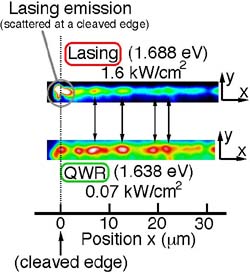The bottom image represents the top-view PL image of QWR at weak excitation power, and at ground state QWR emission energy.
The zero-position represents the cleaved edge of the sample, and the 1D QWR is formed along the horizontal direction, at the center of PL image.
There exists photoluminescence inhomogerneity along the wire. direction, but the size of each luminescence center is about 3 $\mu$ m.
So we believe that carriers inside the QWR region at least diffuse 3 $\mu$m along the 1D QWR direction.
The upper image is the top-view emission image at lasing condition, at very strong excitation power, and at lasing photon energy.
Strong emission peak is recognized at the cleaved edge.
This very strong emission is the lasing emission, scattered at the cleaved edge of the sample.
On the other hand, there is no strong emission pattern inside the cavity. It means the stimulated light doesn't leak inside the cavity, so the waveguide structure is very uniform.
So the emission pattern inside the cavity represent the spontaneous emission pattern at lasing condition inside the cavity, so the gains are mainly obtained in these bright regions.
Note that the bright emission pattern at lasing condition is very simillar to the emission pattern of QWR.
So this fact also suppots that the origin of the stimulated smission is the higher order transition of QWR, not from the Side-QW.
Next Page
